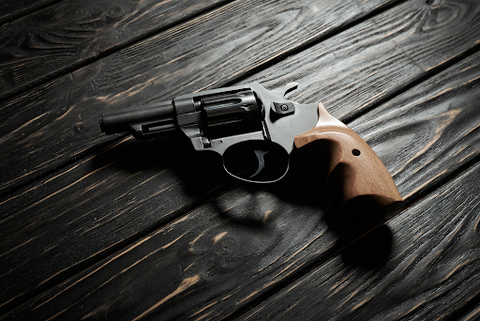Revolvers are not like other kinds of firearms. They require manual reloading and do not hold as many rounds as modern firearms. Since these particular gun types are different from typical firearms, let's try to understand how they operate.
What Is a Revolver?

Credit: Envato Elements/ cavanimages
A revolver also referred to as a wheel gun, is a type of handgun with numerous chambers, each of which can accommodate one bullet. These guns are referred to as "revolvers" because with each cock of the hammer, the cylinder revolves or spins. To better understand how a revolver works, let's first understand its parts.
Parts of a Revolver
The modern revolver is made up of four basic subsystems:
- The Frame Group
- Cylinder, Extractor, and Crane Group
- Barrel and Sight Group
- Trigger Group
Let's go over each group individually.
The Frame Group

Credit: Envato Elements/ Sandsun
This group is made up of the trigger guard, the primary frame, and the hand grip. Its functions include providing a stable frame to support the strong force of the cartridge discharge, ensuring that the trigger operates flawlessly.
Cylinder, Extractor, and Crane Group

Credit: Envato Elements/ kitzstocker
This group makes up the cylinder, the spindle which revolves around, a cylinder release, the crane, and the extractor.
The cylinder is where the ammunition is held. For a revolver, the cylinder normally has six steel chambers, one for each round of ammo. The crane is the part that pivots out and supports the cylinder. The extractor pushes the cartridges out when the shooter pulls the trigger. And lastly, the cylinder release is a small spring-loaded lever on the left side of a revolver. Its function is to enable the cylinder to swing out so that rounds can be loaded and unloaded.
Barrel and Sight Group

Credit: Envato Elements/ svitlanah
The accuracy of the firearm greatly depends on the barrel and sight group.
The barrel is the cylindrical tube through which a projectile is fired. In the case of a revolver, the barrel is rifled, which provides the bullets with a stabilizing spin as they leave the gun. The sights are made up of a front sight and a rear sight to help shooters aim better. In addition to this, there are also low- and no-light sights, and optical sights.
Trigger Group

Credit: Envato Elements/ Sandsun
The trigger group is best described as the firing sequence that begins when the shooter pulls the trigger. It is made up of the trigger and the hammer.
The hammer is the movable component that is aligned with the barrel and situated behind the cylinder. It fires a round by striking a cartridge primer or a firing pin. The trigger is the metal component that the shooter pulls back with their finger to fire the revolver.
How Does a Revolver Work?
There are two distinct action types for revolvers. The action type explains how the gun works. Revolvers can be of a single and double action mode:
1) Single-Action Revolver

Credit: Envato Elements/ ozaiachin
In single-action revolvers, the shooter requires to manually pull the hammer. With the chamber lined up with the barrel, this movement moves the cylinder to the following round and locks it in position. When the trigger is released, the hammer is let go, which forces the cartridge to fire into the chamber. As soon as this happens, a series of events occurs that ignite the gunpowder in the bullet casing and causes the slug to be extracted from the cylinder and sent down the barrel of the firearm with the help of the extractor. The hammer needs to be manually cocked once more in order to fire. Because the trigger only releases the hammer once, it is referred to as a "single-action" weapon.
2) Double-Action Revolver

Credit: Envato Elements/ Photobalance
In a double-action revolver, the shooter has to use only the trigger to simultaneously cock and release the hammer. The benefit of double-action revolvers is that each shot will always be consistent because the same pull weight and length are used. However, when compared to single-action revolvers, these guns typically have a stiffer trigger pull.
The majority of double-action weapons are designed to be DA/SA, or Double-Action to Single-Action, weapons. This means that the first round will be discharged with a double-action trigger pull, where the trigger simultaneously cocks and releases the hammer, and that all following rounds will be single-action. In a DA/SA, the recoil of a fired cartridge pushes the slide back, expels the spent case, and chambers a fresh round.
Summary
A revolver is a fairly basic type of gun. Its structure and operation are both simple. If you take the time to understand how revolvers operate, you will value the weapon more. While you're here, be sure to browse through EasyShot shooting targets for targets that you can always rely on.

